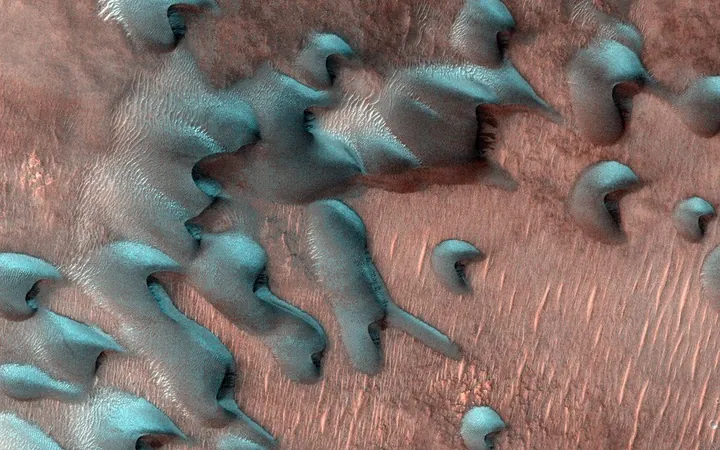
Discover the Unbelievable Martian Snow: Cube-Shaped Flakes and Carbon Dioxide Frost!
2025-01-07
Author: Rajesh
When we think of snow, our minds often drift to serene landscapes blanketed in white, cozy days by the fireplace, or the chaos of sudden winter storms back on Earth. But did you know that snow also falls on Mars? Yes, the Red Planet has its very own winter weather, but it's nothing like what we experience here on Earth!
Mars, much like our home planet, has four distinct seasons, with a winter that can be incredibly harsh. Interestingly, a single Martian year lasts about 687 Earth days, which means each season, including winter, lasts nearly twice as long as the seasons we know and love. During winter, temperatures on Mars can plunge to a staggering -123°C (-190°F) at the poles!
What Does Martian Snow Look Like?
The snow that falls on Mars is unlike any snow here on Earth. Studies using data from rovers and orbiters have revealed that Martian snow consists primarily of water ice and carbon dioxide, or what we call dry ice. While on Earth, snow often creates soft white layers, Martian snow has a unique behavior: water-ice snow tends to evaporate before it even reaches the ground due to the planet's thin atmosphere, a phenomenon known as sublimation. However, dry-ice snow can land on the Martian surface, with enough accumulation to create a surface suitable for snowshoeing!
Snowy Regions of Mars
Interestingly, snow on Mars primarily occurs at the polar regions when there's sufficient cloud cover and during the nighttime—when the planet is turned away from the Sun. While numerous images of recalled snow and frost exist, capturing the act of snow actually falling remains elusive. Rovers currently on the surface struggle to venture into these snowy areas, and cloud cover presents challenges for orbiters who hope to witness snowfall in real-time.
NASA's Mars Reconnaissance Orbiter has been pivotal in revealing this phenomenon. Its Mars Climate Sounder is equipped to detect the elusive carbon dioxide snow, using wavelengths of light outside the visible spectrum. This advanced technology has confirmed CO2 snowfall on Mars, and in 2008, NASA's Phoenix lander contributed further insights by detecting snow falling from Martian clouds!
Strange Snowflakes of Mars
What truly fascinates scientists is the unique shape of Martian snowflakes. According to planetary scientist Sylvain Piqueux, dry-ice snowflakes on Mars are cube-shaped and incredibly tiny, even smaller than a human hair's width! This unusual geometry results from the molecular structure of carbon dioxide ice. While terrestrial snowflakes famously exhibit six symmetrical sides, Mars's snowflakes possess a distinctive four-sided symmetry.
More Than Just Snow: Frost on Mars
Frost is a much more common sight on Mars than snow. Both water and carbon dioxide can form frost in this alien environment. Historical imagery from NASA's Viking landers in the 1970s already documented Martian frost, but recent discoveries have taken our understanding further. In 2024, the European Space Agency's exploration revealed frost on the towering Tharsis volcanoes, even reaching to the frigid equator! This remarkable frost is as thick as a human hair, with an astonishing total mass of 150,000 tonnes of water—equivalent to the water in 60 Olympic swimming pools.
As winter melts away on Mars, the landscape transforms, leaving behind intriguing surface features, including the mysterious formations known as "spiders" that have intrigued scientists for years.
Unlocking the Mysteries of Martian Winters!
While Mars might not host snowmen and ski resorts as Earth does, the captivating nature of its winter conditions offers a glimpse into a very different world. The interplay of carbon dioxide frost, cube-shaped snowflakes, and a landscape sculpted by winter weather paints a vivid picture of Martian winters. As exploration continues, who knows what other secrets may emerge from the chilly depths of the Red Planet? Keep your eyes on the skies—Mars has many more surprises in store!
 Brasil (PT)
Brasil (PT)
 Canada (EN)
Canada (EN)
 Chile (ES)
Chile (ES)
 Česko (CS)
Česko (CS)
 대한민국 (KO)
대한민국 (KO)
 España (ES)
España (ES)
 France (FR)
France (FR)
 Hong Kong (EN)
Hong Kong (EN)
 Italia (IT)
Italia (IT)
 日本 (JA)
日本 (JA)
 Magyarország (HU)
Magyarország (HU)
 Norge (NO)
Norge (NO)
 Polska (PL)
Polska (PL)
 Schweiz (DE)
Schweiz (DE)
 Singapore (EN)
Singapore (EN)
 Sverige (SV)
Sverige (SV)
 Suomi (FI)
Suomi (FI)
 Türkiye (TR)
Türkiye (TR)
 الإمارات العربية المتحدة (AR)
الإمارات العربية المتحدة (AR)